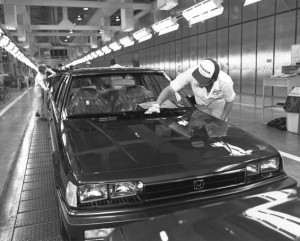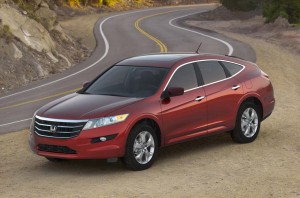
Detroit dared the Japanese to "build cars where you sell them." Initially reluctant, makers like Honda - which opened the first Japanese auto "transplant," in Marysville, Ohio, in 1982 - soon embraced the idea.
Be careful what you ask for, goes the old axiom, as you just might get it. Someone should have told that to Harold “Red” Poling, the former Ford Motor Co. Chairman, who liked to taunt the Japanese, back in the early 1980s, to “build them where you sell them.”
Back then, the imports were still a relatively modest, if fast-growing force, and buoyed by a lopsided exchange rate, makers like Toyota and Honda were able to sharply undercut their Big Three foes. Eliminate the yen from the equation, went the conventional Detroit wisdom, and the imports would lose their competitive edge.
It was an era when the mantra, “Buy American,” still resonated with some buyers, especially when spoken by the likes of Lee Iacocca, the Chrysler chairman and consummate TV pitchman.
But what really mattered to the Asian makers was the passage of so-called “voluntary” restraints on Japanese automotive imports. The severe limits initially appeared to provide a real advantage for Detroit, immediately reducing both the sales and share of brands like Toyota. If there weren’t enough Corollas, import-oriented buyers would have to settle for Ford Escorts and Chevrolet Cavaliers. Better yet, Detroit could raise its prices – by hundreds of dollars per vehicle, according to research of that era, since it didn’t have to compete so hard.

The 2010 Honda Crosstour is just one of the newest models to roll off a foreign-owned "transplant" assembly line.
Unfortunately, the flip side was that the Japanese also could raise their prices, and by even more than the Big Three. After all, consumers were being told that makers like Honda were so good, they had to be restricted or they’d run Detroit out of the market. You can’t get a better endorsement. Suddenly, Japanese automobiles were starting to command higher prices than American products – something we still see today.
But the Japanese weren’t content to stick with the voluntary limits. So, they took Red Polling’s dare. On September 10, 1979, Honda opened up a modest little motorcycle plant in the farming community of Marysville, Ohio. And most everyone rightly suspected that it was simply a way of testing the waters for something bigger. Rightly so, for just three years later, in November 1982, Honda expanded the facility and began rolling out Accord sedans.
In quick succession, a who’s-who of Japanese makers announced plans to add “transplants” of their own, including Nissan in Smyrna, Tennessee. Some of the smaller makers, like Suzuki, Mazda and Mitsubishi, opted for joint ventures with their U.S. allies – GM, Ford and Chrysler, respectively.
Toyota, the lumbering Japanese giant, also saw the need for a U.S. production base. The big question, back then, didn’t involve exchange rates, but worker attitudes; could Americans deliver the same quality, on the assembly line as the dedicated Japanese auto worker? Toyota took a typically cautious approach, 25 years ago agreeing to a rare joint venture of its own that brought back to life an abandoned GM plant near San Francisco. Renamed NUMMI, for New United Motor Manufacturing, Inc., it proved to the Asian maker that American workers could do a far better job than anyone had expected, convincing Toyota to steadily expand its North American manufacturing base.
Today, the company operates more than a half-dozen U.S. and Canadian plants – though NUMMI, Toyota’s only unionized assembly line – is about to close. Those plants account for more than half of all the cars branded Toyota that the industry giant sells here.
Honda, meanwhile, has produced more than 13 million cars at Marysville and another plant, in East Liberty, Ohio, alone. It will soon add the new CrossTour model to the line-up of American-made products.
Japanese makers aren’t the only ones who’ve taken Red Polling at his word. Volkswagen tried and failed to build cars in the U.S. even before Honda. But the plant, in Westmoreland, Pennsylvania, was an example of how to do everything wrong – largely modeled after Detroit’s excesses and failures. Costs were high, quality was low, and VW ultimately shut it down.
When BMW came along, 15 years ago, it had a better role model to choose from, and though it didn’t target the high-volume strategies of the Japanese, it has certainly fared better than VW – which is getting ready, it turns out, to try again, with another U.S. plant, part of its strategy to boost sales in the American market to at least 800,000 a year.
Even the Koreans have come to the States. Despite their own favorable exchange rate and low wages, Hyundai and Kia are both operating American assembly lines.
Why? Politics, of course, are a key reason. Most of the foreign makers now bill themselves as “American” automakers. Toyota has run a series of ads, in recent months, talking about the 50,000-plus U.S. jobs it has created. Subaru even promotes the environmental work it has done around its plant.
The foreign-owned makers have followed a canny strategy of placing their factories in typically anti-union states, primarily in the South, largely offsetting the once-powerful pro-Big Three forces in the House and Senate.
There are other reasons why the transplants keep growing. Shipping costs, for one thing, help offset labor and exchange rate advantages, in many cases. And by operating close to the market where they sell, a maker like Toyota can respond much more quickly to shifts in demand. That was especially apparent, last year, when fuel prices soared to record levels, triggering automakers to rapidly ramp up small car and hybrid production. When you add the two months it can take to bring cars from Asia to the U.S., it’s difficult to impossible to respond quickly enough.
Not all the transplants have been as successful as others. The Subaru plant long operated below capacity – until the small maker partnered with Toyota – and Mitsubishi, sans Chrysler, has never come close to capacity in Bloomington, Illinois. But, on the whole, the Asians and Europeans have effectively paired demand and capacity, driving both ever higher – while Detroit has steadily been in retreat.
Be careful what you ask for, Red Poling. The Ford CEO thought that his foreign rivals would be hamstrung by the same limits that had crippled Detroit. Instead, the transplants rewrote the rules, increasing productivity and quality to levels the Big Three couldn’t imagine.
So, while Detroit may have a smaller share of the market than ever, the transplants have helped make sure that a large portion of the cars, trucks and crossovers we buy continue to be produced nearby.

What the transplant automakers weren’t hamstrung by, that Detroit automakers were, was god-awful management.